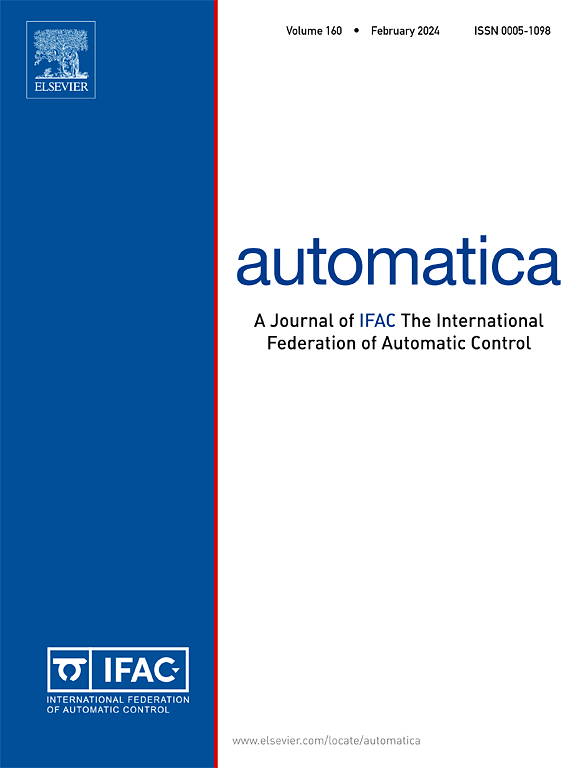Results on sparsity and estimation accuracy in Orthogonal Matching Pursuit with application to optimal input design
IF 5.9
2区 计算机科学
Q1 AUTOMATION & CONTROL SYSTEMS
引用次数: 0
Abstract
Appropriate excitation conditions are essential for reliably identifying sparse models. In regression problems, these conditions are often characterized by properties of the regressor matrix, with mutual coherence, the maximum correlation between regressors, playing a central role in enabling sparse recovery. However, obtaining sparse estimates is rarely the sole objective, as estimation accuracy is also important. When a model is used in an application, e.g. control design, acceptable performance with high probability can be (approximately) ensured by requiring the confidence ellipsoid to be contained in a certain ellipsoid which depends on the performance specifications in the application. However, it is well known that experiments fulfilling such requirements using minimal excitation energy (least-costly experiments) tend to generate highly correlated regressors, in conflict with the requirements for sparsity. Adhering to this setting and focusing on the popular orthogonal matching pursuit algorithm (OMP), we derive conditions for simultaneously ensuring sparsity and having the confidence ellipsoid contained in a pre-specified ellipsoid. We extend this result to a recently proposed two stage sparse estimation method where a linear transformation is used in a pre-processing step before OMP to reduce mutual coherence. A final contribution is to show that our theoretical results are of importance in optimal input design for sparse models. Specifically, we show that the choice of hyperparameters in a recently proposed input design method can be guided by our contributions and we show explicitly how this can be done in this two-stage method.
正交匹配追踪的稀疏性和估计精度及其在最优输入设计中的应用
适当的激励条件是可靠识别稀疏模型的必要条件。在回归问题中,这些条件通常以回归量矩阵的性质为特征,具有相互相干性,回归量之间的最大相关性,在实现稀疏恢复中起着核心作用。然而,获得稀疏估计很少是唯一的目标,因为估计精度也很重要。当一个模型在应用中使用时,例如控制设计,通过要求置信椭球包含在某个椭球中(这取决于应用中的性能规范),可以(近似地)确保高概率的可接受性能。然而,众所周知,使用最小激励能量(成本最低的实验)来满足这些要求的实验往往会产生高度相关的回归量,这与对稀疏性的要求相冲突。在此基础上,以目前流行的正交匹配追踪算法(OMP)为研究对象,导出了保证稀疏性和置信椭球同时包含在预定椭球中的条件。我们将这一结果扩展到最近提出的两阶段稀疏估计方法中,该方法在OMP之前的预处理步骤中使用线性变换来减少相互相干性。最后的贡献是表明我们的理论结果在稀疏模型的最优输入设计中是重要的。具体来说,我们展示了在最近提出的输入设计方法中超参数的选择可以由我们的贡献来指导,并且我们明确地展示了如何在这种两阶段方法中完成这一点。
本文章由计算机程序翻译,如有差异,请以英文原文为准。
求助全文
约1分钟内获得全文
求助全文
来源期刊

Automatica
工程技术-工程:电子与电气
CiteScore
10.70
自引率
7.80%
发文量
617
审稿时长
5 months
期刊介绍:
Automatica is a leading archival publication in the field of systems and control. The field encompasses today a broad set of areas and topics, and is thriving not only within itself but also in terms of its impact on other fields, such as communications, computers, biology, energy and economics. Since its inception in 1963, Automatica has kept abreast with the evolution of the field over the years, and has emerged as a leading publication driving the trends in the field.
After being founded in 1963, Automatica became a journal of the International Federation of Automatic Control (IFAC) in 1969. It features a characteristic blend of theoretical and applied papers of archival, lasting value, reporting cutting edge research results by authors across the globe. It features articles in distinct categories, including regular, brief and survey papers, technical communiqués, correspondence items, as well as reviews on published books of interest to the readership. It occasionally publishes special issues on emerging new topics or established mature topics of interest to a broad audience.
Automatica solicits original high-quality contributions in all the categories listed above, and in all areas of systems and control interpreted in a broad sense and evolving constantly. They may be submitted directly to a subject editor or to the Editor-in-Chief if not sure about the subject area. Editorial procedures in place assure careful, fair, and prompt handling of all submitted articles. Accepted papers appear in the journal in the shortest time feasible given production time constraints.
 求助内容:
求助内容: 应助结果提醒方式:
应助结果提醒方式:


